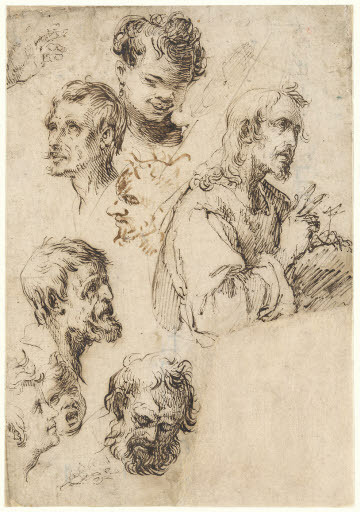
Francisco de Herrera, d. J. ("El Mozo"), Zeichner
Segnender Christus; Kopfstudien, 1640-50
This sheet with various figure studies is a fine example of the problems posed by efforts to classify old drawings. It was initially ascribed to Antonio del Castillo y Saavedra, an attribution that Priscilla Muller rejected in 1963. Alfonso E. Pérez Sánchez disagreed with Muller's disattribution in 1966, while in 1975 Jonathan Brown assigned it to Franciso de Herrera the Younger. Benito Navarrete Prieto and Fuensanta Garcia de la Torre failed to include it in their 2008 catalogue of Castillo drawings but Enrique Valdivieso has since attributed it to the latter, once again.[1]
As a rule, Castillo's study sheets, most of which were drawn with a broad reed pen, are structured more homogeneously, presenting various views of one or two heads. They do not tend to include groupings of different heads. Brown's attribution is based on stylistic features typical of Herrera, especially in the Christ figure.[2] However there are also similarities to drawings in the Museo de Bellas Artes of Córdoba that are attributed to Agustin del Castillo (1569–1626), Antonio del Castillo's father and teacher.[3] The cheekbones, the treatment of the hair and beards, and the less homogenous hatching are much the same.
This sheet was closely cropped at the left edge. At the top, only the left hand remains from what was presumably a larger figure; in the bottom left, only part of a head remains; and a large section in the bottom right, probably with another head, has been removed. The sheet was apparently backed at the time of the Echeverría inventory, since the mounting paper is of the same quality and bears the same watermark as some of the pages of that compilation. Since this paper was commonly used in England, increasingly in the eighteenth century, it is conceivable that it was shipped to Seville at the behest of Richard Ford by Dominik Colnaghi in London,[4] and the drawing was therefore backed in the mid-1830s-along with the other drawings, which at that time were in the possession of Julian Benjamin Williams.
Jens Hoffmann-Samland
1 In a personal conversation in May 2012, for which I thank him, Valdivieso pronounced it Castillo y estupendo además."
2 Brown 1975, 238. He did not describe these features in detail, however in two of the heads, one sees the eye squiggles that Brown had identified as typical of Herrera.
3 Drawings of Saint Peter, Saint Paul, and Old Man inv. nos. CE0893D, CE0894D, and CE0895D.
4 In a letter to Dominik Colnaghi dated September 8, 1832, Richard Ford had asked for a "blank book for mounting Drawings," which he wished to use as a gift in Seville and which was to be sent by way of Messrs Macarthy to Julian Benjamin Williams. His description of what the book was to look like and how the cover should read approximates the way the present Hamburg collection (at the latest) was mounted when Mr. Cosens took possession of it: “stout paper, of creamy white colour, gilt edges, the book very handsomely bound with much tooling, either a rich purple or Claret colour & lettered above: DIBUJOS ORIGINALES and underneath MURILLO: A. CANO; VALDES &c" (Bean 1995, 105). It is not documented that such a book actually arrived in Seville from London. In a further letter from December 1832, Ford requests among other things an indication of what the book that had not yet been sent would cost: "as well as for the book to be sent to Mr Williams" (Bean 1995, 106). We have no documents indicating it was ever received. See the introduction to this volume.
